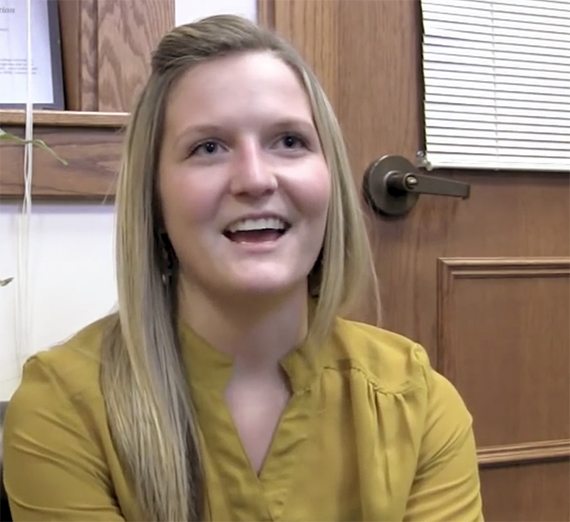Danielle Hyatt Earns Prestigious Summer Science Job

By Peter Tormey
SPOKANE, Wash. — Gonzaga junior Danielle Hyatt, from the tiny Chicago suburb of Sandwich, Ill., takes a big step this summer toward her dream of becoming a heart surgeon and researcher. She will work in the lab of Dr. Shahin Rafii at Weill Cornell Medical College in New York City, thanks to a highly selective program of the Howard Hughes Medical Institute.
A biology major, Hyatt becomes Gonzaga's fourth scholar accepted into HHMI's Exceptional Research Opportunities Program. The program pairs the Institute's prestigious investigators with top students from disadvantaged backgrounds or groups traditionally underrepresented in the sciences.
The growing Gonzaga HHMI alumni legacy includes Isaac Strong ('10), and 2012 alumni Fernando Rodriguez Perez and Nicolas Contreras — all of whom received summer research opportunities with some of the world's top researchers. Biology Professor Nancy Staub has successfully recommended all four to the plum assignments that can fast track a science career.
Hyatt, one of only 77 students chosen nationwide for the program, is excited to work in Dr. Rafii's lab, since he is both a physician and a medical researcher - the same twin "M.D. and Ph.D." roles to which she aspires. Rafii's research focuses on the molecular and cellular pathways involved in organ regeneration and tumor growth.
Hyatt's interest in cardiology — specifically cardiac electrophysiology, study of the heart's electrical activities — is personal. Danielle and her twin sister Dawn both have tachycardia, a faster than normal heart rate, and have seen specialists most of their lives. The twins are the first members of their family to attend college. Dawn studied at University of Kentucky, and is applying to pharmacy school. They have two older brothers.
"I really want to have patient contact so I want to be a doctor, a surgeon," Hyatt said. "And I want to do research on various electrical components that can go wrong with the heart."
Hyatt visited Gonzaga and two other Jesuit schools, both in California, but felt most at home on Gonzaga's campus.
"Gonzaga was, by far, my favorite," she recalls. "It was a beautiful sunny day. There were people sitting on the grass, people playing Frisbee. I had a great all-around feeling about Gonzaga. The academics are amazing here. Pretty much everything about Gonzaga was perfect. Being in a smaller school, there are so many opportunities that can just lift you and take you places."
For example, she studied last semester at Trinity College in Dublin. During Christmas break, she traveled to Cusco, Peru to serve as a volunteer in a medical clinic.
Hyatt credits all of her teachers for her success, especially Professor Staub.
Hyatt and her Gonzaga boyfriend Tony Vecchiolla, a biochemistry major who recently switched to economics, came here together from the Chicago area. She attended an all-girls school, Rosary Catholic High School; he an all-boys school, Marmion Military Academy. Their wedding is set for July 4, 2014.
Last year, Gonzaga received a $1.2 million HHMI grant allowing its science faculty to better develop students as socially responsible leaders in science, research, and medicine. It's part of more than $50 million HHMI awarded to 47 small colleges and universities, and is Gonzaga's second major HHMI grant. In 2008, Gonzaga was among 48 of the nation's best undergraduate schools to share $60 million from HHMI to help usher in a new era of science education in the United States. The 2008 HHMI grant has been "transformative" for Gonzaga's already successful science programs and has more than tripled research opportunities for undergraduates, Professor Staub said.
Professor Staub said Hyatt has taken full advantage of the opportunities Gonzaga has provided.
"Danielle has always been a go-getter," Professor Staub said. "She actually discovered the EXROP from her own sleuthing on the Internet as a sophomore. To improve her chances of being one of Gonzaga's nominees to the program, I suggested she get research experience at Gonzaga first. She applied and was accepted to work in Dr. Bill Ettinger's lab, studying calcium transport in chloroplasts. We recommended her for the EXROP program last fall."
Staub said EXROP is one of many good examples of how Gonzaga's HHMI grants provide outstanding opportunities for students.
"The research-based discovery lab we now run for more than 350 students each year as part of our introductory biology courses is another good example," Staub said. "We were able to start that program as a consequence of an additional grant we received through HHMI."
